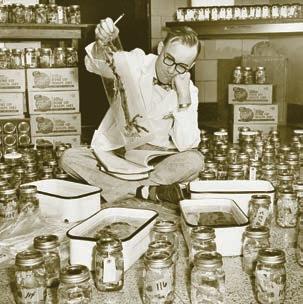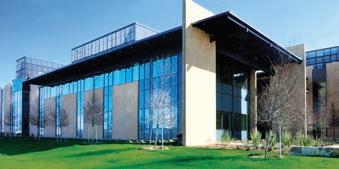
8 minute read
A Timeline of Our History
Our History
A Timeline of Our Story
Advertisement
1940s
• December 16, 1941, Tom Slick, Jr. formed the Foundation of Applied Research at age 25. He sought to create a research organization to meet the challenge of bettering mankind. The
Foundation, located on the famed “Essar Ranch” in San Antonio, Texas, was formed with the mission to provide fundamental research and advanced education in agricultural research, the natural sciences, and medicine. The ranch’s name “Essar” was chosen as a phonetic symbol of S and R, the first letters of scientific research. • 1947, Foundation
of Applied Research
opened its first laboratory building on the Cable Ranch property. Initial research focused on agriculture and cattle breeding.
• Harold Vagtborg – served as Administrative
Director, 1961-1970
• 1963, Hixon
Animal
Research
Laboratories
were completed. SFRE tripled in size with the addition of the Ferdinand D.
Herff Memorial Research Laboratory, the
Chimpanzee Breeding Building and the
Primate Quarantine Building.
• May 1967, The first shipment of chimpanzees from the Congo arrived on campus. First assigned name was Harold.
• 1962, Tom Slick Jr. died in a plane crash in Dillon, Montana at the age of 46. • 1963, Dr. Seymour S. Kalter joined
SFRE to study microbiology and infectious diseases, and developed the baboon as a model to study viruses.

1960s
• 1961, Surgeons worked on techniques to
keep organs alive outside
the body before transplantation.
Studies conducted included cardiovascular disease, ovarian function, and lipid metabolism in the brain.
1970s
• 1970, The Southwest Foundation Forum was chartered as a women’s group to promote the work of the Foundation in the community through education and fundraising programs.
In 1977, the Golden Circle was created to increase the philanthropic support of the Foundation by individuals and businesses. The symbol represents the unending search for truth and knowledge, the essence of scientific research. • 1971, SFRE developed totally
germ-free infant
baboons by isolating them from the outside world. These special baboons were used to study various cancers, specifically leukemia.
• 1971, The Foundation library was rededicated as the Preston G.
Northrup Memorial
Library, in honor of
Mr. Northrup’s contributions to the library since its inception. • 1973, Dr. Henry C. McGill Jr., M.D., joined SFRE and became the first
Scientific Director in 1979.

• Harold Vagtborg, D.Sci. (Hon), L.L.D.
FAR First President,
1948-1959
1950s
• 1951, Dr.
Nicholas T.
Werthessen, who studied cardiovascular disease and atherosclerosis, joined FAR. He initially used calves as an animal model until baboons were discovered to have fatty deposits in the aorta, similar to humans. • 1952, The Foundation of Applied Research (FAR) is renamed
Southwest Foundation for Research and
Education (SFRE). • 1953, First grants awarded by the
National Institutes of Health (NIH).

• 1956, First baboon colony established at SFRE from animals acquired from the local zoo.
• Elbert DeCoursey, M.D.
SFRE President,
1959-1961
• 1958, NIH and Texas
Heart Association
provided funds to support the baboon colony to study the effects of heart disease with the baboon animal model.
Construction of the baboon cages (aka baboonery) began. • 1958, First
expedition to
Kenya to acquire animals. Six grown male baboons were shipped to SFRE from Africa. • 1956, Betty Slick Moorman, Tom Slick’s sister and Foundation trustee, purchased and restored The Argyle as a private social club to support the Foundation’s research.

• 1978, The National Cancer
Institute supported the chimpanzee colony for critical cancer studies. In 1979, the NIH National Heart, Lung and Blood Institute awarded
SFRE a contract to maintain an NIH chimpanzee colony for hepatitis research. • 1979, the tether system allowed arterial pressure and heart rate to be measured in awake baboons. Dr. Dee
Carey, Terry Hawkins, and Dr. Robert Shade continued to refine it.

• Stanley W. Olson, M.D.
SFRE President,
1970-1972
• Martin A. Goland
SFRE President,
1973-1982
1980s
• 1981, SFRE was the world’s only primate center with cardiac catherization and angiography equipment. The special x-ray machine enabled scientists to examine the heart and its arteries.
• 1981, The Southwest Foundation Forum funded researchers to develop a model to study infant respiratory distress syndrome. Researchers studied the use of the high frequency ventilator to provide premature baboons with lower airway pressure. • 1983, The world’s first nonhuman primate was born on July 25 from an in vitro fertilized embryo and was named
“E.T.” (Embryo Transfer). • 1983, Dr. Jorg Eichberg and Dr. S.S.
Kalter began studying the AIDS virus using baboons and chimpanzees as a nonhuman primate model. • 1984, Dr. Jean MacCluer and Dr.
Bennett Dyke developed computerized statistical methods for analyzing populations genetic data. • 1984, Southwest Foundation for Research and Education was renamed Southwest Foundation for Biomedical Research.


• 1986, “Florentina”, a 10-week premature chimpanzee became the first chimpanzee placed on a high frequency ventilator.
• 2003, The AT&T Genomics Computing
Center opened with 3,000 processors, improving the ability of scientists to identify genes influencing common diseases.
• 2004, Dr. Robert Lanford and
Dr. Krishna Murthy continued their work to develop a Hepatitis C virus vaccine using chimpanzees. Dr. Lanford discovered the first evidence that a vaccine against all strains of the virus could be possible.
• 2012, Dr. Tim Anderson and Dr. Ian Cheeseman were involved in two studies identifying a major region of the malaria parasite genome associated with artemisinin resistance. • 2012, Dr. Robert Lanford and his team tested a human monoclonal antibody targeting the Hepatitis
C virus and found that it protected chimpanzees from HCV infection in a dose-dependent manner.
Dr. Lanford has been involved in the testing of new antiviral therapies for the treatment of chronic hepatitis infections. Today, two antiviral cocktails are FDA approved and others are near approval that can cure HCV with 12 weeks of daily oral medications.
• Anthony J. Infante, M.D.,
Ph.D. SFBR President,
2005-2006
• John C. Kerr, J.D.
SFBR President,
2006-2008
• 2007, Drs. Harald
Göring, Shelley Cole,
David Rainwater,
Anthony Comuzzie, Jean MacCluer, et al. discovered the VNN1 gene that plays a major role in the regulation of HDL (good) cholesterol levels and may play a part in heart disease prevention. • 2008, The Department of Organic
Chemistry becomes Evestra, a private pharmaceutical company to produce new contraceptives and treatments for breast and prostate cancer. • 2009, Dr. Laura Cox, et al. identified a variant in a gene that regulates levels of “good” cholesterol using the SNPRC’s pedigreed baboon colony.
• 2010, Dr. Andrew
Hayhurst studies the use of llama antibodies to quickly detect microbes and toxins that could be used in bioterrorism attacks. In 2014, his lab identified antibodies that recognized a small conserved region of protein in Marburg virus with a very similar architecture to Ebola virus. • 2011, Southwest Foundation for Biomedical Research was renamed Texas Biomedical
Research Institute (Texas Biomed).

2010 to today
• 2013, In separate studies, scientists
Dr. Robert Davey,
Dr. Jean Patterson and
Dr. Ricardo Carrion,
Jr. reported findings of two drugs that protected mice against anthrax, while another drug used to treat malaria protected mice against Ebola.
• Duncan G. Wimpress, Ph.D.
SFRE President,
1982-1992
1990s • 1990, Genetically
engineered AIDS vaccine
protected two chimpanzees at the Foundation from infection.
• 1991, The Mexican
American Program Project funded by NIH to support the
San Antonio Family Heart study. Dr. Jean MacCluer led a team of 20 researchers to identify specific genes that influence susceptibility to coronary heart disease in
Mexican Americans. • 1991, SOLAR, a genetic analysis software package developed by SFBR scientists and now used by more than 5,000 researchers worldwide, was released.
• 1996, Dr. Jean Patterson joined SFBR as the chair of the Virology and Immunology department. She was instrumental in opening and designing the maximum biocontainment laboratory to study threats in bioterrorism. She began the first studies using select agents including anthrax and tularensis.
2000s
• 2000, The Biosafety
Level 4 Lab became fully operational.
SFBR is the only institution in the country to house both a BSL-4 lab and a national primate research center.
• Frank F. Ledford, Jr., M.D.
SFBR President,
1992-2005

• 1997, The Foundation broke ground on the 34,000 sq. ft. Betty Slick and Lewis J. Moorman, Jr. Laboratory complex.
• 1999, The NIH National Center for Research
Resources announced the establishment of the eighth Regional Primate Research Center (SNPRC) in the country at SFBR.
Southwest National Primate Research Center
• 1997, The Department of Genetics began to identify genes influencing food intake and body fat endocrine function. Research on these genes helped aid in the identification of individuals at risk of developing obesity and, potentially, in the development of treatments to prevent obesity and related conditions.

• 2014, The Earl Slick Building, named in honor of Tom Slick’s brother for his role in the institute’s development, opened with 70,000 sq. ft. of laboratory and office space. • 2015, Dr. Robert Davey publishes findings in the journal “Science” on a small molecule inhibiting Ebola virus infection in vitro. • 2016, NIH awards Texas Biomed $23 million program project to work on AIDS vaccine development led by Dr. Ruth Ruprecht. • Kenneth P. Trevett, J.D.
SFBR/Texas Biomed President,
2008-2014
• Robert W. Gracy Ph.D.
Texas Biomed President,
2014-2017
• Dr. Larry S. Schlesinger
Texas Biomed President,
2017









